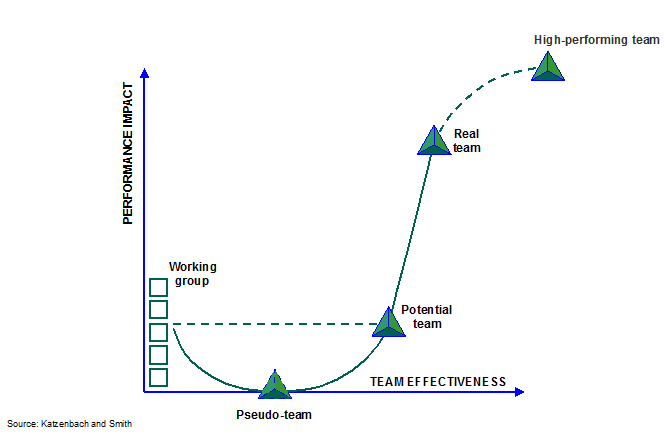Would you have Kevin Pieterson on your team? Does trust matter for performance?’
We are often asked to work with senior leadership teams to improve their performance. I talked in an earlier blog about the need to align teams with the strategy to deliver it successfully.
And of course, the teams themselves need to be high performing for the success of any business. So, where do you start and how do you know whether the team is performing at its highest potential?
Firstly we would ask the team to assess individually where they would put their X on Katzenbach and Smith’s high performing teams curve (see the diagram above). Gaining a realistic perspective is a good starting point. I am always amazed at the differences in opinions and at the over-assessment of where the team is on the curve.
Once we know where we are starting from we can put in place a plan to improve the team performance.
1. Create team purpose
The first and obvious factor is a sense of team purpose. This purpose needs to be shared, ambitious, motivating for everyone and linked clearly to the overall business goals.
We can spend quite a lot of time with a team just agreeing this purpose. We then put them on the spot and encourage them to articulate this purpose to a wider audience in a way that is motivating for others who may need to execute it.
In my experience no-one leaps out of bed “to deliver shareholder value”. Any senior leadership team needs to be able to translate the bigger goal in to meaningful actions for those further down the organisation.
2. Clarity of individual roles and responsibilities
The second factor that is critical is for everyone in the team to be clear about individual roles and responsibilities. Have you got all the resources you need to perform well, do you need external support in specialist areas? Have you defined the performance criteria and standards for these roles so that you can assess performance?
3. Collective accountability
If you have these factors in place it then allows you to have a sense of collective accountability (factor 3) and to be able to hold feet to the fire if individuals are not performing to agreed standards. Only the team can fail, not one individual in the team. As Ricky Gervase in The Office said “There is no ‘I’ in team”.
4. Strengths of individuals in teams
It is wise of course to play to the strengths of individuals in the team (factor 4) rather than put people in roles where they are performing on the back foot. If you have someone whose role is to build relationships with customers then don’t give that role to an introvert who finds face to face interactions uncomfortable!
All of this requires honest and robust conversations in the team. Too often we find teams who have different factions and undercurrents that are not properly addressed. This takes courage to tackle and can be uncomfortable as you work through the issues. If you don’t, then the team gets stuck and never moves up the performance curve. We can facilitate these difficult conversations to enable the team to break through to a higher level of performance.
And when you have all of these factors, then you have a team built on trust.
In the news today Andrew Strauss said that they wouldn’t be re-instating Kevin Pietersen in the England cricket team as there was not trust between him and the English Cricket Board.
So even though he scored 360 runs yesterday, proving his competence, it is not deemed enough to overcome the lack of trust.
Teams who trust each other are able to challenge, conduct the tough conversations, and deliver the very best performance. At the same time, we find that these teams, as well as delivering, have enormous fun. They work hard but with a positive attitude and have a real sense of achievement when they produce the results. They know how to celebrate success as well as deal with the difficulties along the way.
Are you in a high performing team? Where would you put your team on the curve?









